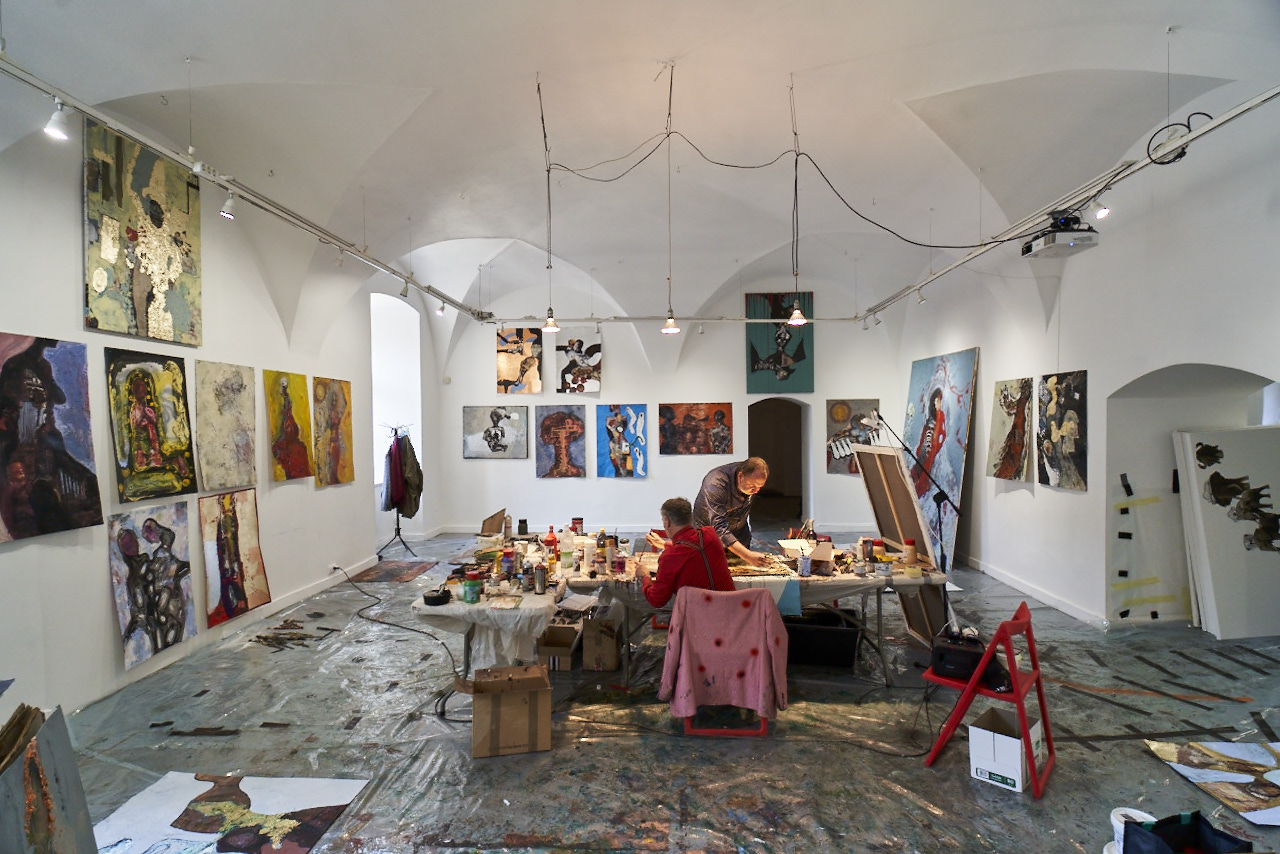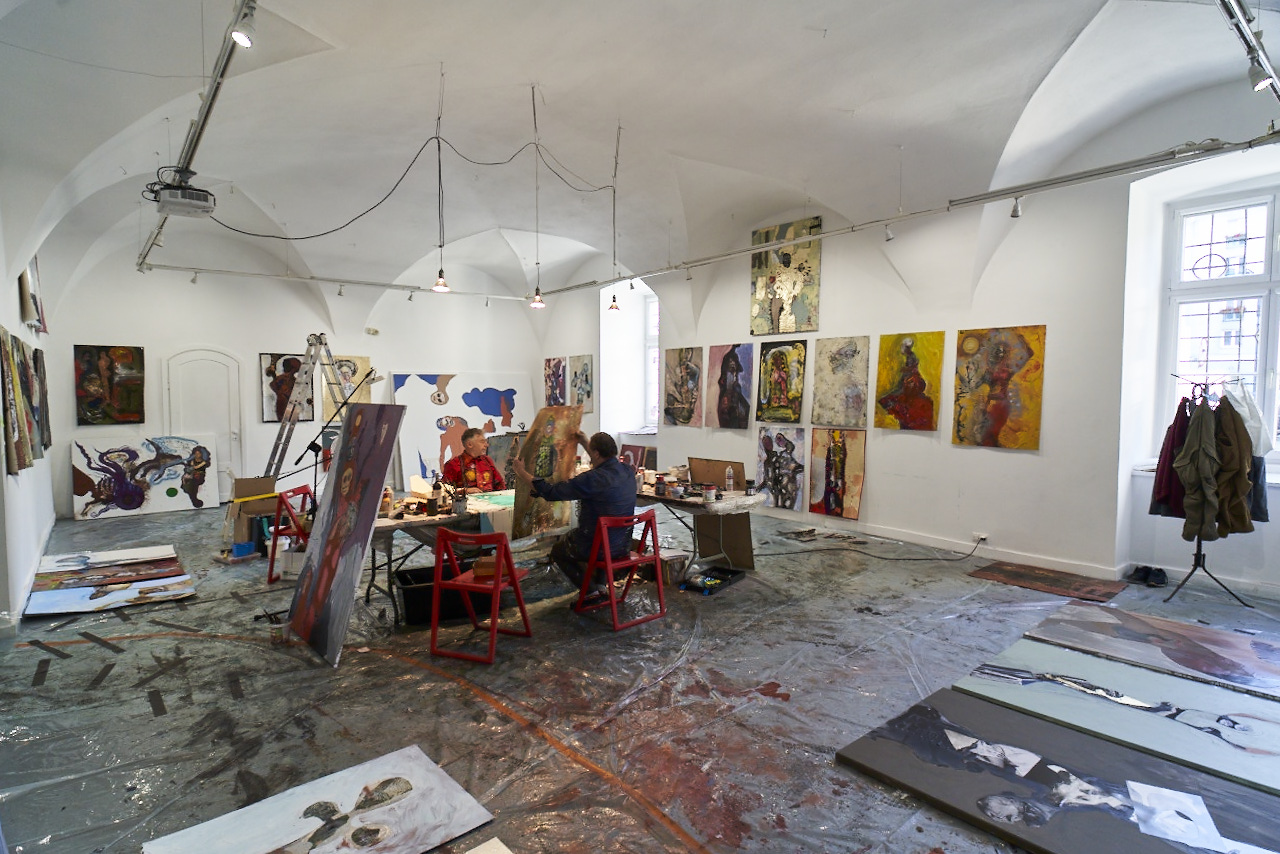Polish School of Collage
Exhibition by Paweł Althamer and Artur Żmijewski.
What how did you come up with the idea for the Polish School of Collage? How did it start? Why are you doing this, gentlemen?
Artur Żmijewski: We have been doing it for a long time. A couple of years. It started with drawing projects. It turned out that it is easier to draw and glue projects, because it is better than talking about them. This practice gained autonomy and became a kind of conversation on any given topic. We called it, a little ironically, the Polish School of Collage for the purposes of this exhibition.
What do you create collages from? What tools do you use?
A.Ż.: We mainly use old books, large illustrations on various topics. There are landscapes, but also portrait photography, old sculpture catalogs, anatomical atlases. Various things that can be used and become so to speak a construction of this image, which is created later, and which can completely disappear under the layers of collage painting. They are a kind of provocation, but well-constructed. A provocation mainly for ourselves, to have something to “bounce back” from, relate to, a context to act.
What “secret knowledge” do these collages contain? I mean the concept of pleasure that Paweł Althamer spoke openly about.
A.Ż.: The pleasure of making collages lies in being able to break away from my own artistic practices and Paweł also distances himself from his own practices. This is taking a time off from the easy art, one could say, from one’s own ailments related to this art. This work is more fun, completely free, and may not be conclusive. Some of these things go wrong. Some of them are repainted many times. These pictures can be very, very tired at the end. But basically it is a break from your own practice, talking on various topics with the help of pictures.
What were the motivations behind the recent collages – the time of isolation caused by the epidemic? What images will be edited?
A.Ż.: Very different. Most often it is dictated by what can be found in an antiquities shop or bookstore at a discount or what can be bought on Allegro – in the sense of pictures, visual material ready for processing. These are very different things, such as Edward Hartwig’s photo albums, thanks to which I have recently refreshed my memory of his photography, albums with anatomy, anatomy of the head, but also anatomy of farm animals, a lot of Norwegian landscape, but also the St. Mary’s Altar by Wit Stwosz, very beautifully photographed, including heads, characters, landscapes, which, as elements, became a pretext for activity.
What type of sensitivity can we expect?
A.Ż.: Rational sensitivity. Collages are sensitively and vigilantly constructed. These are quite complicated performances, often multi-layered. I also think that something interesting can be expected…
What does the work on collages in the studio look like? How do you experience autonomy and partnership in work creation? What field is left for the viewer?
A.Ż.: Anyone who wants to think can see the excess of these pictures. On the other hand, this cooperation is actually a conversation where the subjects are images, their fragments, some whole or larger assemblies of various kinds. Everyone has a place for themselves, there is no scope or limit of activities. The work of each of us is such a fairly free exchange. Sometimes I feel like the daimonion is leading us, sometimes it’s more of a river, sometimes there’s a bit of a struggle in that. There is a lot of such a game and meeting of the unknown. You also need to be able to stop at the right moment. Besides, all things work, such as caring for the composition, the color, and the content as well, because these pictures are often very attractive. And you need to know when to stop, to discontinue, so as not to take a step too far and not lose what was interesting.
To what extent can the audience from Kalisz join the work in the Gallery, which functions like a studio, and can follow the various stages of collage creation?
A.Ż.: The audience can follow the successive stages of creating collages, absolutely. Will we cooperate? That, I don’t know. It will probably come out in the process. People are not so eager to join the work. You have to create special conditions for them to join. I do not know what it will be like, but it is a situation rather from the open category, that is, let’s say, a workshop situation. That’s how I see it.
Joanna Dudek interviewed Artur Żmijewski on August 31, 2021.

fot. Dominik Kulaszewicz
Collages are made of fragments cut from albums about art, photo and anatomical albums, which the artists put together in surprising and dense compositions. The multi-layered painting works have a clear color and texture. Body, nude, extermination, abstraction are some of the themes appearing at the exhibition, but none of them dominate. Despite the fact that, over the years of struggle in the field of critical art, artists have accustomed the public to calls for an uprising and revolution, we will not find any politics in the collages. Its place is taken over by reflection on art. The works require concentration, insight into the context, and sensitivity.
Paweł Althamer and Artur Żmijewski are among the most recognizable Polish artists. They met in the studio of Professor Grzegorz Kowalski, known as Kowalnia, at the Sculpture Department of the Academy of Fine Arts in Warsaw. They made their debut in the nineties and since then they have been part of the canon of Polish and world art. Since graduation, they have stayed in touch, are friends, as well as collaborate and exhibit together. During their joint residence in Japan, they started a series of works on paper, using ink and stamps. They have been creating collages since 2017.

Fot. Domink Kulaszewicz
Paweł Althamer
Born in 1967, he lives and works in Warsaw; sculptor, author of artistic activities, installations and videos. In his work, starting from the experience of a specific physical “I,“ he blurs the boundary between what is individual and social, between private and public space, between representation and reality, making realistic sculptures from perishable materials, modest interventions into reality, and extensive projects involving collaboration and participation of other entities or groups, e.g. the homeless, children, residents of a block of flats in a Warsaw housing estate, or staff working in galleries. Since 1994, he has been running weekly ceramic workshops for people suffering from multiple sclerosis at the National Artistic Center “Nowolipki“ in Warsaw; their joint works are exhibited as Paweł Althamer & Grupa Nowolipie. His works have been shown, among others during individual exhibitions in The Neighbors New Museum, New York (2014), Almech Deutsche Guggenheim, Berlin (2011), or One of Many, Fondazione Nicola Trussardi, Milan (2007), as well as collective exhibitions in As you can see. Polish Art Today, Museum of Modern Art in Warsaw (2014), Performa 13 New York (2013), The Encyclopedic Palace. 55th Venice Biennale, Venice (2013).
Artur Żmijewski
A visual artist associated with the Foksal Gallery Foundation, one of the representatives of critical art in Poland. In 1990-95, he studied at the Sculpture Department of the Academy of Fine Arts in Warsaw. He represented Poland at the 51st Biennale of Contemporary Art in VeniceThe with the film Repetition. From 2006, he was the artistic editor of the Krytyka Polityczna magazine for several years. Today he cooperates with the journal a rank and file editor. He is a laureate of the prestigious Ordway Prize (2010) awarded jointly by the New Museum in New York and the Creative Link for the Arts organization; Fondazione Sandretto Re Rebaudengo Per L’Arte awards in 2000 and TVP Kultura awards in the category “Alternative Culture and Visual Arts.” His most famous works include: Oko za oko [Eye for an eye] (1998), Berek [Tag] (1999), Lekcja śpiewu 2 [Singing Lesson 2] (2003) , KR WP (2000), Na spacer [For a walk] (2001), Nasz śpiewnik [Our Songbook] (2003), 80064 (2004), Polak w szafie [The Pole in the Wardrobe] (2006), Katastrofa [Catastrophe] (2010), Msza [Mass] (2011) He is also the author of the film Oni [They], shown as part of Documenta 12 in Kassel in 2007 and the film Spojrzenie [Gaze], shown in Kassel as part of Documenta 14. He is also the author of film series Demokracje i Wybrane prace [Democracies and Selected Works]. He was the curator of the 7th Berlin Biennale of Contemporary Art (2012). In 2013, he was awarded the Jerzy Stajuda Art Criticism Award.
EXHIBITION DURATION: September 6 – October 16, 2021
Closing of the exhibition with the artists’ participation – Friday, October 1, 2021, at 7 pm – 10 pm
ORGANIZER:
The Jan Tarasin Art Gallery in Kalisz
CULTURE INSTITUTION OF KALISZ
The exhibition Polish School of Collage is an event accompanying
The 61st Kalisz Theater Meetings – the Festival of Acting Arts
GALLERY PARTNERS
ERGO HESTIA, POLIFARB KALISZ S.A., M&P ALKOHOLE I WINA ŚWIATA
MEDIA PATRONAGE
Radio CENTRUM, CALISIA.PL, ZIEMIA KALISKA.








